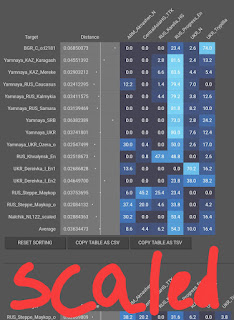We have one sample from north Caucasus PG2004 which is similar to so called BP group of Caucasus Lower Volga cline.
Modeling Yamnaya as a three-way mixture of CLV_BP, Aknashen and Ukraine Neolithic hunter gatherers was very easy, as in the paper.
It didn't require from me any extra effort to find the correct "settings" (outgroups). Adding western Ukraine Trypllia farmers didn't made the model better. Aknashen was still wanted while Trypllia not. I tried various ways to make Trypllia wanted, but it didn't work. Finally, I removed Aknashen and forced the model to rely solely in Trypllia. I got a p value lower than 0.05. So practically a failure. Nikitin 2024 dedicates a special chapter to this subject. Their conclusion is that Yamnaya probably do have some Trypllia but it's very low.
My conclusions are the same. Aknashen ancestry in Yamnaya is real. It is supported by Y DNA of preceding period, and I am sure that the scrupulous analysis of mtDNA will show the same result. Finally, if I had access to the Nalchik farmer data then the percentage would be twice higher.
Then I tried the same in G25 and here a surprise. The raw unscaled models behaved in the same manner as qpadm albeit with a different proportion. But the scaled G25 showed a clear a preference for Trypllia. I said in this group many times that tools and settings matters. And this an excellent example why the use of scaled models can lead to misleading results. I want to remind that scaled coordinates are artificially altered numbers.
Keeping this in mind let's see what means CLV-steppe ancestry in Bronze Age Anatolia that Lazaridis 2024 supposedly has found but Lazaridis 2022 didn't detected. I don't have Cayonu files to reproduce their models in qpadm but what we know from G25 behavior is that:
+ When Anatolia N and CHG are used in models as source they mask the steppe ancestry and show a lower number. This was done in Lazaridis 2022 which not only didn't find any steppe in BA Anatolia but even in Van Urartu.
+ When a Mesopotamian or Levantine and Iran Neo are used as sources and CHG and Anatolia_N are ommitted then this exaggerates the steppe ancestry in northwest Asia. In Lazaridis 2024 they used Cayonu Neolithic which was a north Mesopotamian population. This exaggerated the steppe ancestry in Bronze Age Anatolia where Hittite lived. If the same Cayonu was used for Minoans, they would find steppe even in Minoans and probably Alalakh Hurrians and Semites also. Which doesn't make sense. Uniparental markers do NOT support such high level of CLV-steppe ancestry in BA Anatolia. Quite contrary they speak about very low or virtual absence of it. Just one R1b-V1636 in the midst of more than dozen local haplotypes.
My conclusions are that based on this genetic data it is not possible to consider IE homeland issue fully solved. We are very close it. And the broad picture. But the exact details are not still there, and linguistics also can be helpful.
What is needed now is to have more than 50 Y DNA from Bronze Age Anatolia. Also, a large number of Y DNA is needed from South Caucasus and historic Armenia LC-EBA period to see what happened to those Late Chalcolithic migrants from north. How much they left an impact and why their autosomes were diluted after the Areni C. It is also important to have samples from LC kurganic burials like Aknalich and Soyuq Bulaq.
See also





No comments:
Post a Comment